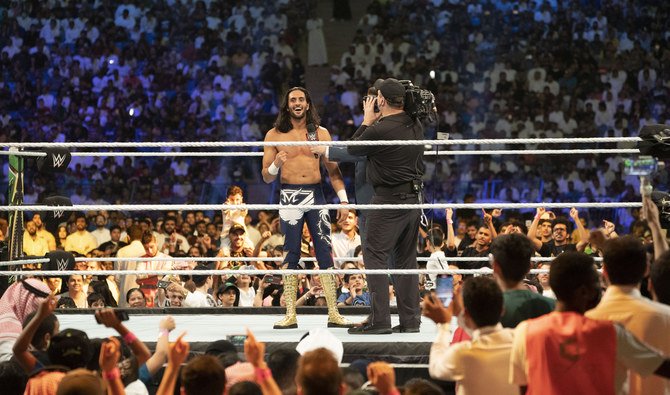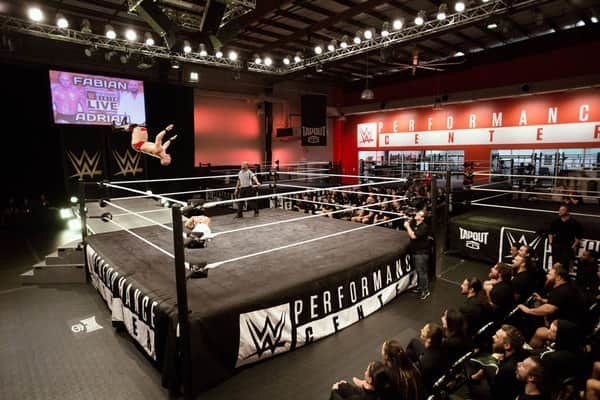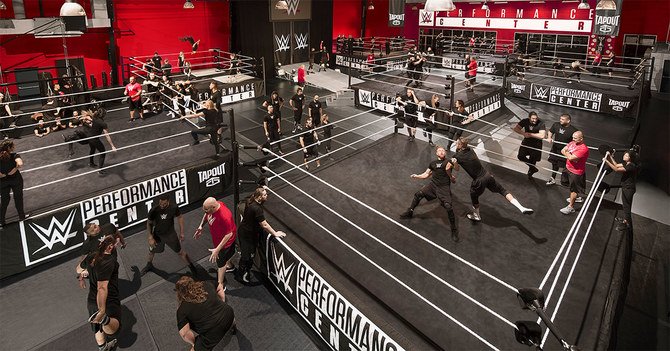





Hussam Al-Mayman and Aseel Bashraheel, Riyadh
Mansoor Al-Shehail, World Wrestling Entertainment’s first Saudi star, celebrated another career milestone last week, in front of a hometown crowd.
The rookie defeated veteran Swiss wrestler Cesaro in their first one-on-one encounter, during the WWE Crown Jewel 2019 event at Riyadh’s King Fahd International Stadium on Oct. 31.
Mansoor introduced himself to the global WWE audience in memorable style in June when, during the televised Super ShowDown event at King Abdullah International Stadium in Jeddah, he outlasted 50 other wrestlers to win the largest Battle Royal in WWE history.
The 24-year-old said that training to become a wrestler had been a completely different experience from the sports in which he had participated when he was younger.
“My sports history was with football (soccer) in Saudi Arabia, and fencing in America,” said Mansoor.
His interest in fencing grew out of a love of the Star Wars movies, in particular their sword-fighting-style lightsaber battles.
“Fencing wasn’t what I expected — in a good way,” said Mansoor. “It required a lot more finesse and tremendous footwork and balance control. Football, meanwhile, was a lot more about conditioning, precision and also footwork, to a different degree.”
The training that was required when he decided to switch to wrestling was completely different from both of his previous sports.
“There are people who look at what we (wrestlers) do and say, ‘Hey, I think I could do that.’ But so many of us are specially trained and are good at what we do, we make it look easy — and that’s by design.”
Mansoor was invited to train at the WWE Performance Center in Orlando, Florida, after he was spotted by WWE scouts during tryouts in Jeddah ahead of the Greatest Royal Rumble event in 2018. He said that many of the athletes he met at the center who had come from other sports, including boxing and American football, told him that training for the wrestling ring was the hardest thing they had ever done.
“It’s something that you need to have a passion for and love, otherwise the punishment and the pain that you experience just simply isn’t worth it,” he said. “If you don’t have that love for what we do, for the sport, in your heart then your body is not going to be able to withstand the punishment.
“It’s different in the sense that it’s an emotionally grueling process — I can’t even describe it. Physically, it puts you at the absolute top of your game. The strength and conditioning they have with the coaching and the program is something that I had never encountered before coming (to the WWE Performance Center).
“I was not on a really strict regimen — I was always sort of athletic, in a sense, so I could naturally do quite a bit and I was very grateful for that — but the limits that (the coach) can push you through and the maximum potential that he can push you to is amazing.”
The performance center, which has 26,000 square feet of training facilities, is at the heart of the WWE’s talent-development program. It has seven full-size wrestling rings, a fully equipped strength and conditioning room, a sports-medicine facility, and a promo room with a private studio for perfecting on-camera techniques, including character development and performance skills. There is also a cutting-edge production and editing suite with a studio and voice-over booth.
Mansoor said that thanks to the training he received there, wrestling moves are now second nature to him.
“When I’m in the ring it’s not so much as case of thinking about what I’m going to do next, its that I’ve done this so much I just naturally know what to do in any situation, at any given time and in any scenario,” he explained.
“I think that’s what I’m most grateful for: the ability to make wrestling second nature, to make what I do in the ring more of an instinct than a planned thought. I think that will help me a lot in the long run.”